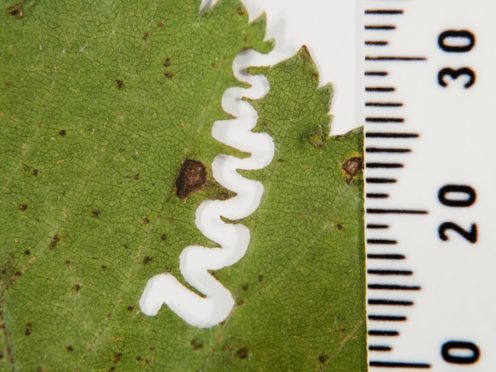A pest which leaves a signature trail of destruction on elm leaves reminiscent of the Mark Of Zorro appears to have arrived in the UK, experts warn.
The zigzag elm sawfly, originally found in Japan, feeds only on elm leaves and has been progressing steadily through Europe.
Now scientists at the Royal Botanic Garden Edinburgh (RBGE) have confirmed the telltale zigzag feeding trail left behind by the sawfly larvae has been found on leaves collected in Surrey during autumn 2017.
The discovery has raised concerns it could pose another blow to the UK’s elms, which have already been devastated by Dutch elm disease, and threaten wildlife that rely on the trees.
The distinctive “signature” of the zigzag elm sawfly (Aproceros leucopoda) might conjure images of Zorro, but RBGE scientists confirm it heralds the arrival of a new pest in the UK and could threaten elm-dependent insects https://t.co/fqEnsT8G4C #planthealth pic.twitter.com/7GPQNjGe05
— RBGE (@TheBotanics) June 21, 2018
Elm leaf-feeding insects such as the rare white-letter hairstreak butterfly, which suffered in the 1970s due to the loss of trees to Dutch elm disease, could be hit by the new pest’s arrival.
While the zigzag elm sawfly rarely kills trees, large populations can completely defoliate elms, which could be disastrous for the white-letter hairstreak whose populations are sometimes restricted to single trees, the experts said.
The first evidence of the pest in Britain was a chance discovery, according to scientists at RBGE.
RBGE mycologist Dr Katherine Hayden said: “Plant samples arrived here to be identified as part of local plant recording activity carried out by experienced amateurs in Surrey.
“Examination by our elm specialist revealed the curious zigzag feeding damage as the first evidence of the pest in Britain.”
RBGE science communicator Max Coleman said: “The zigzag elm sawfly can quickly build up pest populations as females are able to reproduce asexually.
“People will be familiar with how fast greenfly can spread. The sawfly has evolved the same strategy: exploit the speed advantage of asexual reproduction and avoid the risk of not finding a mate.”
Scientists are now asking people to report sightings of the unmistakable zigzag pattern, to track the sawfly’s spread and help scientists secure definitive evidence of its presence in the form of adult insects, larvae or pupae.
It has also prompted renewed calls for action to protect the UK’s woodlands and wildlife.
Dr Nick Atkinson, senior conservation advisor for the Woodland Trust, said: “This could be another blow to the elm population, following the widespread devastation caused by Dutch elm disease, which began in the 1970s and continues even today.
“By continuing to allow the import of trees and other living materials we are risking the health of our natural landscapes and our own well-being as a consequence.
“Action is needed now. Government, with buy-in from the forestry and horticulture sectors, and even supermarkets that sell plants, need to help minimise further risks to our native trees and woodlands.”
Anyone wishing to report sightings of zigzag elm sawfly can use
https://treealert.forestry.gov.uk
.
